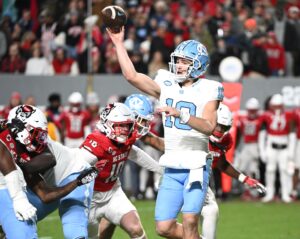The 100th season of NFL football is just a few months away. With that in mind, it’s a fitting time to celebrate the rich history of a league that, let’s face it, has become America’s national pastime. And this article tells a story of a team from the earliest days of the league, the Buffalo All-Americans.
Buffalo, NY has been a part of the NFL from the beginning. That much is obvious considering that the All-Americans were one of the 14 original teams from the league’s inaugural season back in 1920 when it was known as the American Pro Football Association. They finished that season as the highest scoring team in the league and with the third-best record behind the Decatur Staleys and eventual champion Akron Pros.
If not for a 3-0 loss to the Canton Bulldogs on November 21, the All-Americans would’ve gone unbeaten and claim the league’s first championship. A year later, they were in the title chase once more and, after knocking off the Dayton Triangles 7-0 on November 27, finished the regular season with a record of 8-0-2. That should’ve given them the 1921 title, the last season when the league was known as the APFA.
But as will be discussed here, a few factors precluded them from prevailing that year.
How the Buffalo All-Americans Lost the 1921 NFL Championship
Prior to 1933, there was no title game to determine the league champion. Basically, the team with the best record by winning percentage at the end of the regular season took home the title. That should’ve been the All-Americans in 1921 as their record at the conclusion of play that year was tops among a league that had suddenly ballooned to 21 teams. It included another Buffalo area club, the Tonawanda Kardex, who played a single game that year before departing the league. They remain the shortest-lived team in NFL history.
But back to the All-Americans. Spearheaded by player-coach and part owner Tommy Hughitt, the team lost just a single game over the course of their first two seasons in the NFL. They formed a trio of dominance with the Pros and the Staleys who moved to Chicago from Decatur, IL in 1921. The teams all finished top-three in the NFL standings during those inaugural two years.
So what transpired that prevented them from being named champs. It turned out to be a rather complicated situation that emerged as the first significant controversy in NFL history. A combination of self-inflicted wounds and the machinations of one of the more prominent figures in the early history of the league played its part. Before there were uproars over supposed cover-ups regarding the dangers of head injuries, perceived leniency for perpetrators of domestic violence, or kneeling during the national anthem, there was the “Staley Swindle.”
What Was He Thinking?
In retrospect, the primary owner of the All-Americans at the time, Frank McNeil, should’ve sent his players home after they knocked off Dayton. But for reasons that remain perplexing to this day, he decided to stage two exhibition matches afterward. Not only that, but they were to occur on consecutive days starting with December 3. That day, they would take on Akron in Buffalo only to hop on a train immediately thereafter for a matchup with the Staleys in Chicago the following day.
McNeill was confident that the games would have no bearing on the standings. And perhaps there was some sense of hubris in thinking that his team wouldn’t lose either game anyways. The first matchup went as planned, with the All-Americans prevailing over Akron in fairly decisive 14-0 fashion. But fatigue was always going to be an issue in having to play football games on two straight days with a 500+ mile train ride in between. Still, the All-Americans put up a spirited fight against the well-rested Staleys on Sunday, December 4. They lost by a narrow 10-7 scoreline.
McNeill, Hughitt, and the All-Americans initially had nothing to fear. In their minds, the two games they played over this late autumn weekend in 1921 were meaningless from the standpoint of determining the league champion. Unfortunately, that was not an opinion shared by George Halas, the owner of the Staleys who would later change their name to the Bears.
When a Championship Was Determined Off the Field
Throughout its history, the NFL is full of final results mired in controversy. The most recent example was the Los Angeles Rams win over the New Orleans Saints in last season’s NFC title game. It was made possible due to a horrible no-call as Rams cornerback Nickell Robey-Coleman clearly interfered with Saints wide receiver Tommylee Lewis. But nearly a century earlier, the league’s champion was determined in perhaps the most arbitrary manner ever.
After the Staleys narrowly knocked off the All-Americans, Halas concocted a plan to manipulate his way to a championship. He hastily scheduled two games in December against the Canton Bulldogs and the only NFL charter member other than the Staleys/Bears still in existence, the Chicago Cardinals. If they won both games, they’d have a superior winning percentage to Buffalo and would have a rather bizarre claim to the championship. They defeated the Bulldogs 10-0 on December 11 but exactly a week later, they played the Cardinals to a scoreless tie.
In Halas’ mind, these games were legitimate regular-season contests even though McNeill expressly said the two additional games the All-Americans played weren’t. That gave each team an identical .900 winning percentage. Furthermore, Halas wanted to convince the league owners that if two teams played more than once, the most recent game was more important. Eventually, they agreed. And a mere two years after the Chicago White Sox threw the 1919 World Series, the NFL essentially awarded a fixed title.
The All-Americans: An Essential Part of Buffalo’s Rich Pro Football History
That stolen championship was essentially the high watermark of the All-Americans franchise. Three years later, Hughitt became a majority owner as McNeill sold his stake in the club and changed the team’s name to the Bisons after the Buffalo baseball team that actually played in the Major Leagues from 1879-85. Hughitt retired as a player that year and the team fell into decline afterward, eventually folding in 1929.
Pro football returned to Buffalo 17 years later with the Bisons a charter member of the All-American Football Conference (AAFC). They would change their name to the Bills one year later and had their best season in 1948 when they made league title game, losing to the Cleveland Browns who won all four AAFC titles. After the 1949 season, the NFL decided to absorb three AAFC teams, the Browns, the San Francisco 49ers, and the Baltimore Colts. League owners voted 9-4 to admit the Bills. But in order to become a part of the league, teams needed a unanimous vote. And so the Bills were forced to fold.
A little more than a decade later, the iteration of the Bills that remains to this day came into being as part of the upstart AFL in 1960. The team was founded by a native of Detroit, MI, and a World War II veteran who served in the Navy by the name of Ralph C. Wilson, Jr. Only the Kansas City Chiefs finished with more AFL titles than the Bills who won two straight in 1964 and 1965 under the leadership of quarterback Jack Kemp. And prior to Terry Pegula purchasing the club after he passed away in 2014, Wilson was the third-longest tenured owner in NFL history behind Halas and long-time Pittsburgh Steelers owner Art Rooney.
The highlight of Wilson’s tenure as owner during the team’s NFL days is obviously the four straight AFC championships. Yes, the Bills lost all four Super Bowls but at least those results were determined on the field. The same can’t be said for what should have been the city of Buffalo’s first pro football championship.






